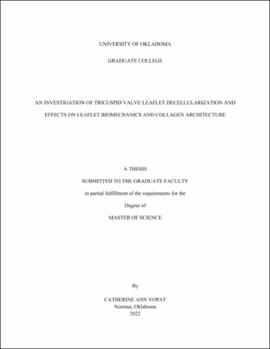| dc.contributor.advisor | Lee, Chung-Hao | |
| dc.contributor.author | Vopat, Catherine | |
| dc.date.accessioned | 2022-05-10T21:02:38Z | |
| dc.date.available | 2022-05-10T21:02:38Z | |
| dc.date.issued | 2022-05-13 | |
| dc.identifier.uri | https://hdl.handle.net/11244/335679 | |
| dc.description.abstract | The Tricuspid Heart Valve is composed of three leaflets: the anterior leaflet, posterior leaflet, and septal leaflet. The function of this valve is to open during diastole to allow blood to flow from the atrium to the ventricle, then close during systole to prevent backwards flow of blood, called regurgitation. Valve regurgitation can decrease the effectiveness of the heartbeat and can lead to death over time. Two common heart valve replacements are mechanical heart valves and xenografts. These options have both shown clinical success, however no replacement currently meets the criteria for hemocompatibility, immunological tolerance, and the potential to grow and remodel itself. The decellularized tissue-engineered heart valve (TEHV) may be the key to achieving all of these goals. Decellularization has the potential to remove any immunogenic markers from the tissue while maintaining the complex microstructure that is vital for proper cell differentiation and remodeling. In this study, an H&E staining procedure was optimized for further use in the lab. Nine decellularization procedures with different exposure times to detergent and enzyme solutions were compared to find the optimal procedure. We found that 24-hour exposure to detergent and 12-hour exposure to enzymes was the optimal decellularization procedure for all three leaflets. This optimized decellularization procedure was then used in a biaxial mechanical and collagen microstructural analysis study to determine if the biaxial mechanical characteristics and collagen fiber architecture change as a result of the decellularization treatment. After statistical analysis of several parameters, we found that there were no statistically significant changes from the pre-treatment values to the post-treatment values due to decellularization reagent exposure. These results provide strong evidence that the chosen decellularization procedure is effective at decellularizing the tissue while maintaining the microstructure architecture and mechanical properties of the native leaflet. | en_US |
| dc.subject | Tissue Engineered Heart Valve | en_US |
| dc.subject | Heart Valve Decellularization | en_US |
| dc.subject | Decellularized Heart Valve Tissue Mechanics and Microstructure | en_US |
| dc.title | An Investigation of Tricuspid Valve Leaflet Decellularization and Effects on Leaflet Biomechanics and Collagen Architecture | en_US |
| dc.contributor.committeeMember | Acar, Handan | |
| dc.contributor.committeeMember | Breen, Sarah | |
| dc.date.manuscript | 2022-05-06 | |
| dc.thesis.degree | Master of Science | en_US |
| ou.group | Gallogly College of Engineering::Stephenson School of Biomedical Engineering | en_US |
